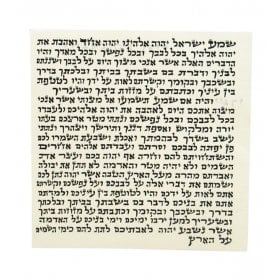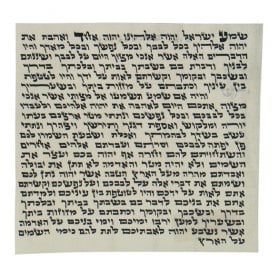Kosher Mezuzah Scrolls - Handwritten & Certified
All of our mezuzah scrolls are hand written on quality shelil parchment (klaf shelil) and certified kosher after being scanned by a computer and proofread by an expert scribe. you can choose between Ashkenazi tradition and Sephardic tradition. We offer special prices for quantities.
-
 Mezuzah Scroll Ashkenaz Version Made in Israel 100% Kosher with CertificateSize: 6cm / 2.4" - 12cm / 5"$45.00 - $45.90
Mezuzah Scroll Ashkenaz Version Made in Israel 100% Kosher with CertificateSize: 6cm / 2.4" - 12cm / 5"$45.00 - $45.90 -
 Large Kosher Mezuzah Scroll Sefardi VersionSize: 15cm / 6"$90.49 - $125.83
Large Kosher Mezuzah Scroll Sefardi VersionSize: 15cm / 6"$90.49 - $125.83 -
 Mezuzah Scroll Sephardic Version Made in Israel 100% Kosher with CertificateSize: 6cm / 2.4" - 12cm / 5"$45.00 - $45.90
Mezuzah Scroll Sephardic Version Made in Israel 100% Kosher with CertificateSize: 6cm / 2.4" - 12cm / 5"$45.00 - $45.90 -
 Mehudar Enhanced Kosher Mezuzah Scroll - AshkenaziSize: 6cm / 2.4" - 12cm / 5"$100.61 - $125.83
Mehudar Enhanced Kosher Mezuzah Scroll - AshkenaziSize: 6cm / 2.4" - 12cm / 5"$100.61 - $125.83 -
 Mehudar Enhanced Kosher Mezuzah Scroll - SephardicSize: 6cm / 2.4" - 12cm / 5"$100.61 - $125.83
Mehudar Enhanced Kosher Mezuzah Scroll - SephardicSize: 6cm / 2.4" - 12cm / 5"$100.61 - $125.83 -
 Large Kosher Mezuzah Scroll Ashkenaz VersionSize: 15cm / 6"$90.49 - $186.23
Large Kosher Mezuzah Scroll Ashkenaz VersionSize: 15cm / 6"$90.49 - $186.23
Mezuzah Scrolls - The Inside Story
Our site offers a huge variety of attractive and impressive Mezuzah cases. But this should not distract you from awareness that what is most important is what's inside the case. So, here is "The inside story"!
Inside the mezuzah case is a parchment scroll on which is inscribed two Torah passages. Over 4000 Torah laws and specifications govern details of the parchment, the writing and even the manner in which the scroll is folded and placed inside the mezuzah case before it is affixed to the door post.
Kosher Certificate
So, it is vital that your mezuzah carries an authorized certificate testifying to its kashrut. Without it, you cannot be certain that all the laws have been properly observed. Sadly, many people unknowingly have beautiful mezuzah cases adorning their homes with invalid parchments inside. When you buy a mezuzah scroll from aJudaica, you can be confident that it meets all halachic requirements and carries the appropriate certificate of impeccable kashrut.
Writing a mezuzah is a responsible job that demands devotion, precision and artistic talent. The sofer (scribe) must be a pious and G-d fearing man who will pen the holy texts with great concentration. As he works, he prays for Divine Guidance, reciting to himself, "I am writing a holy mezuzah". When the name of G-d is written, extra concentration and pure thoughts are required.
The Text on the Mezuzah Scroll
The mezuzah text of over 700 letters is written on a parchment of 22 lines. Our Sages defined precisely the style and shape of every letter. One extra letter or one less, a drop of excess ink, a minute correction – can invalidate the mezuzah. The sofer works slowly and carefully. The letters are not allowed to touch each other but they must also not be too far from one another. There are specific guidelines regarding the space between words. Even a small infringement of these laws can affect the kashrut of the mezuzah. Read the Full translation of the Mezuzah text.
Ashkenaz or Sefardi Scroll?
There are two versions of mezuzah – Ashkenzai for Jews originating from Central and Eastern Europe or Sefardi for Middle Eastern (Arabic) and Persian background, whether or not they have any historical or ethnographic connection to the Iberian Peninsula.
The difference between the two is the style of calligraphy. The ruling is that initially, everyone should follow his father's tradition but if for any reason, he has not done so, as long as the Mezuzah is kosher, he is observing the mitzvah.
The Scroll Material
There are many laws regarding the scribe's work items. The parchment, made from the hide of a kosher animal, undergoes a long process of preparation which should preferably be undertaken by G-d fearing people who are aware of the great mitzvah involved. There are two types of parchment – mashu'ach and Shlil. The mashu'ach is cheaper but it wears faster. All aJudaica mezuzahs are from the shlil parchment which of superior quality and durability. The size of mezuzah parchments ranges from 5 cms to 25 cms. The standard size is from 10-12 cms. The quill the sofer uses comes from a kosher bird and is prepared according to a special process.
Price Range
You are probably wondering why there is such a wide range of prices for mezuzahs. The answer is that as with all crafts, there is quality workmanship in parchment writing too. A minimum level of kashrut has poor quality writing and permitted errors but there is mehudar, enhanced beautiful writing. Experienced scribes work slowly and thoroughly, ensuring that every letter meets with the halachic requirements. Their writing has grace and beauty. This is on a higher level of kashrut and obviously commands a higher price.
The Mitzvah
The source of the mitzvah to affix a mezuzah on the doorposts of our homes and offices is the Torah where it writes in (Devorim 6:4-9): “You shall write them upon the doorposts of your home and your gates."
What is written on the mezuzah parchment? The immortal Shema words "Shema Yisrael, Hashem Elokeinu, Hashem Echad" followed by the continuation of the shema prayer - two Torah passages, Devorim 6: 4-9 and Devorim 11: 13-21 recited daily in our morning and evening prayers.
On many mezuzahs, the scribe writes the name of G-d – the letters shin, daled and yud – on the back of the parchment. This is an acronym for the initial letters of the words, Guardian of the doors of Israel.
How to Insert the Scroll
In order to insert the parchment in to the mezuzah case it is always rolled from the end to the beginning. In this way the word Shema will be visible as soon as it is opened. It is then respectfully placed in a small plastic bag. This serves as an additional cover since the ink and the parchment are delicate and can be invalidated by excessive light, sun or dampness. It is also an extra covering for such a holy item, "protecting" it from behavior, sights or conversations that might not be appropriate for such a sacred article.
If you have ordered a mezuzah case together with the parchment, we will roll and insert it into the case and then all that is needed to be done is to attach it to the doorpost. Some of our customers wish to see the mezuzah parchment and then roll it themselves. If this is clearly specified with the order, we will be happy to comply.
As we said earlier on, every aJudaica mezuzah carries a fully-recognized certificate confirming that it meets all the halachic requirements. Before any mezuzah parchment leaves our premises it is thoroughly checked two times – once by an expert examiner who is experienced in this specialized field and then it is computer examined to ensure that not even the slightest flaw has been overlooked.
Warranty
We take pride in the quality of our mezuzah parchments. All have a ten year warranty. Jewish law recommends that mezuzahs be checked once every seven years. If the mezuzah is exposed to sun or water, then it should be checked twice in seven years.
How to affix a Mezuzah
The mezuzah is affixed on every door of your home or office with the exception of bathrooms. It should be attached on the lower part of the upper third of the doorpost that is on the right-hand side when entering the room. Ashkenazim have the custom for the mezuzah case to slope inwards and Sefardim keep their mezuzah straight. The case is affixed with nails, screws, double-sided-tape or glue.
Affixing the mezuzah on your new home or premises is an emotional moment. Holding the mezuzah in one hand and a hammer, screws or tape in the other, you recite aloud the blessing, "Baruch atah Hashem, elokeinu melech ha'olam asher kidishanu be'mitzvatov utzivanu likvoa mezuzah". It is then attached to the wall. Now, you can live in the home, reassured that it has G-d's protection and that you have provided a constant reminder of His presence.
There are many more laws regarding where and when a mezuzah should be affixed. The myriad details are outside the scope of this brief summary. In the event of a query or doubt, a Rabbinical authority should be consulted. In that way, you can be sure that your mezuzah meets halachic requirements and will give your home full protection.
Affixing a mezuzah to the doorposts of our homes is a Divine mitzvah that has a great reward. It has been faithfully observed down the ages as the uniform that identifies a Jewish home and separates it from the rest of the world. On visiting towns where Jews once lived, it is still possible to see indentations in the doorpost where the mezuzah once stood. The mezuzah reflects G-d's love and protection and is an expression of His constant care.
So, we urge you to spare no effort to ensure that your mezuzah parchment is valid and kosher and worthy of the beauty of a Jewish home.